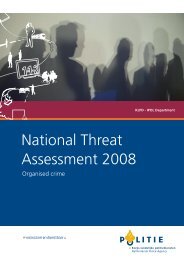Assessing the Effectiveness of Organized Crime Control Strategies ...
Assessing the Effectiveness of Organized Crime Control Strategies ...
Assessing the Effectiveness of Organized Crime Control Strategies ...
Create successful ePaper yourself
Turn your PDF publications into a flip-book with our unique Google optimized e-Paper software.
<strong>Assessing</strong> <strong>the</strong> <strong>Effectiveness</strong> <strong>of</strong> <strong>Organized</strong> <strong>Crime</strong> <strong>Control</strong> <strong>Strategies</strong>:<br />
A Review <strong>of</strong> <strong>the</strong> Literature<br />
command structure and illicit activities, <strong>the</strong> FBI squads obtained eavesdropping orders which<br />
provided evidence that inculpated members and could be used as leverage to obtain <strong>the</strong>ir<br />
cooperation. Prosecutors used <strong>the</strong> evidence in an ongoing series <strong>of</strong> criminal and civil<br />
proceedings.<br />
The <strong>Organized</strong> <strong>Crime</strong> Agency <strong>of</strong> British Columbia (2001/2002) has adopted an intelligence led<br />
enforcement model. This agency uses intelligence to identify key OC figures in order to disrupt<br />
<strong>the</strong>ir activities through prosecution and through <strong>the</strong> seizing <strong>of</strong> assets. Tactical intelligence is<br />
disseminated to law enforcement partners. Internal assessments, primarily using operational<br />
measures, have shown some positive outcomes. For example, considerable evidence has been<br />
shared with law enforcement agencies and OCABC <strong>of</strong>ficers have provided expert evidence to<br />
broaden <strong>the</strong> understanding <strong>of</strong> OC activities by <strong>the</strong> courts.<br />
Many American law enforcement agencies, however, have still not incorporated intelligence and<br />
its analysis into <strong>the</strong>ir OC control efforts (Peterson, 1994: 360). There may be a reluctance to<br />
deviate from more traditional investigative methods and police management may experience<br />
difficulty in evaluating <strong>the</strong> results <strong>of</strong> intelligence analyses. However, it would be difficult to<br />
imagine a successfully completed OC investigation without at least some rudimentary analysis<br />
(Peterson, 1994:384).<br />
The evaluation <strong>of</strong> intelligence work in general is in its early stages. Peterson (1994) notes that<br />
few agencies in <strong>the</strong> US have attempted to quantify <strong>the</strong>ir analytical efforts, let alone evaluated<br />
<strong>the</strong>m. These efforts are <strong>of</strong>ten assessed by <strong>the</strong> number <strong>of</strong> intelligence products generated, ra<strong>the</strong>r<br />
than <strong>the</strong>ir value in achieving certain organizational ends.<br />
4.16 Reducing <strong>the</strong> Supply <strong>of</strong> Illegal Goods and Services<br />
One method <strong>of</strong> hampering <strong>the</strong> activities <strong>of</strong> OC groups is through interrupting or eradicating <strong>the</strong><br />
supply <strong>of</strong> illicit goods and services. This approach has been referred to by Goldstock (1994) as<br />
“opportunity blocking”. Often, but not always, supply reduction occurs in tandem with <strong>the</strong> arrest<br />
and prosecution <strong>of</strong> those involved in <strong>the</strong> smuggling and distribution <strong>of</strong> contraband. This section<br />
will focus on drug trafficking, which is arguably <strong>the</strong> area in which this approach has been<br />
adopted most widely.<br />
The US President’s Commission on <strong>Organized</strong> <strong>Crime</strong> (1986:477) referred to <strong>the</strong> interdiction <strong>of</strong><br />
narcotics as “at best a random and occasional threat.” It also found that source country crop<br />
eradiction would not succeed “unless it is comprehensive, long-term, and visibly supported by a<br />
national commitment” in <strong>the</strong> US to reduce demand.<br />
Perhaps <strong>the</strong> best test <strong>of</strong> <strong>the</strong> potential <strong>of</strong> <strong>the</strong> law enforcement approach to dealing with <strong>the</strong> issue <strong>of</strong><br />
illicit drugs was <strong>the</strong> “war on drugs” launched by President Reagan during <strong>the</strong> 1980s. His<br />
administration recruited an additional 1,000 agents for <strong>the</strong> Drug Enforcement Administration<br />
(DEA) and 200 new assistant US Attorneys. More stringent laws were introduced, 1,300 new<br />
beds were added to 11 federal prisons, and <strong>the</strong> military and Coast Guard was brought in to fight<br />
this war with assault helicopters, AWACS planes, satellites, and high-powered speedboats<br />
(Kenney and Finckenauer, 1995:193). The efforts could be branded a success from a narrow<br />
48 | Research and Statistics Division / Department <strong>of</strong> Justice Canada








